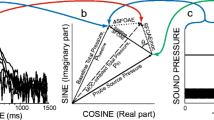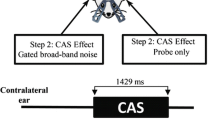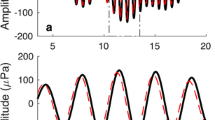Abstract
Distortion product otoacoustic emissions (DPOAE) adapt after primary tone onset, with an ~100 ms time constant, due to feedback effects of medial olivocochlear (MOC) activity elicited by the primary tones. We tracked DPOAE postonset adaptation as a metric of MOC reflex strength, before during and after induction of anesthesia in guinea pigs. Reflex strength was significantly diminished by the barbiturate/neuroleptic anesthesia most commonly used in this species. The MOC reflex recovered more slowly than toe-pinch or startle reflexes, correlating better with recovery of general mobility. When individual anesthetic agents were assessed, the barbiturate (pentobarbital) significantly diminished MOC reflex strength, whereas fentanyl or droperidol did not. These results suggest that previous studies using anesthetized preparations may have underestimated the magnitude of sound-evoked responses in the OC pathway.
Similar content being viewed by others
Author information
Authors and Affiliations
Rights and permissions
About this article
Cite this article
Boyev, K., Liberman, M. & Brown, M. Effects of Anesthesia on Efferent-Mediated Adaptation of the DPOAE. JARO 3, 362–373 (2002). https://doi.org/10.1007/s101620020044
Published:
Issue Date:
DOI: https://doi.org/10.1007/s101620020044




